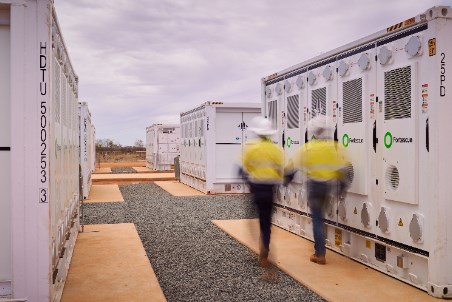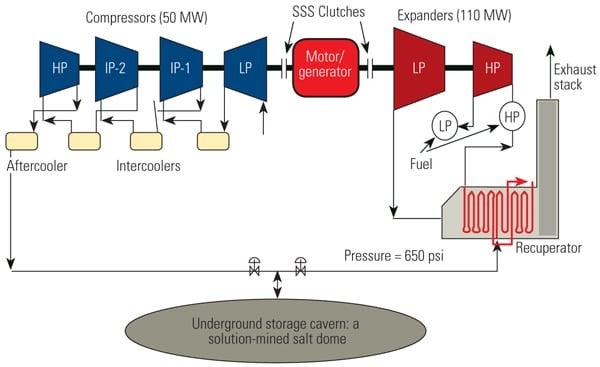BYD unveils world’s largest 14.5 MWh DC energy storage system – ess-news.com

Report on BYD’s HaoHan Energy Storage System and its Alignment with Sustainable Development Goals
Introduction
BYD has launched the “HaoHan” DC energy storage system, a significant technological advancement in the utility-scale storage market. With a single-unit capacity of 14.5 MWh, this system is designed to accelerate the global energy transition and directly supports the achievement of several United Nations Sustainable Development Goals (SDGs), particularly those related to clean energy, infrastructure, and climate action.
System Specifications and Technological Innovations
The HaoHan system and its associated components introduce several industry-leading features that enhance efficiency, reduce costs, and minimize environmental impact.
- HaoHan Energy Storage System:
- Capacity: A minimum unit capacity of 14.5 MWh, with a 10 MWh configuration available in a standard 20-foot container.
- Energy Density: A volumetric energy density of 233 kWh per cubic meter, representing a 51% increase over the industry average.
- Resource Efficiency: For a 1 GWh plant, the system reduces the number of required units by over 50%, land use by 33%, and the cell count by 76%.
- Durability: Designed for harsh environments, it is projected to lower system failure rates and maintenance costs by 70%.
- Blade Battery Technology:
- Cell Capacity: Features a self-developed 2,710 Ah Blade Battery cell, the largest energy storage cell globally.
- Longevity: Offers a cycle life exceeding 10,000 cycles.
- Cost-Effectiveness: Reduces the total lifecycle cost per kilowatt-hour to below CNY 0.1 ($0.014).
- Supporting Infrastructure:
- GC Flux Grid-Forming Inverter: Provides a power density of 1,474 kW/㎡ (130% above industry average) and a peak efficiency of 99.35%. Its advanced grid-forming capabilities, including active inertia response and ultra-fast regulation, are critical for grid stability.
- GC Master Energy Management System (EMS): This “system brain” supports up to 10 million data points and can manage a single-station capacity of up to 15 GWh, representing a 400% increase in computing power over conventional platforms.
Contribution to Sustainable Development Goals (SDGs)
The HaoHan system’s design and capabilities make a direct and measurable contribution to key SDGs.
SDG 7: Affordable and Clean Energy
- Enhancing Renewable Integration: The system’s high capacity and millisecond-level response facilitate the large-scale integration of intermittent renewable energy sources like solar and wind, ensuring a stable and reliable clean energy supply.
- Improving Economic Viability: By reducing the Levelized Cost of Storage (LCOS) by 21.7% and overall project costs by approximately 30%, the technology makes clean energy solutions more affordable and accessible.
SDG 9: Industry, Innovation, and Infrastructure
- Building Resilient Infrastructure: The system’s grid-forming capabilities strengthen energy grids, making them more resilient and capable of handling the demands of modern, renewable-heavy networks.
- Driving Technological Innovation: The development of the world’s largest capacity single-unit system and the 2,710 Ah Blade Battery cell represents a significant leap in industrial innovation for the energy sector.
SDG 11: Sustainable Cities and Communities
- Optimizing Land Use: The system’s high energy density reduces land requirements for utility-scale projects by one-third, a critical advantage for land-scarce urban and industrial areas aiming to build sustainable energy infrastructure.
SDG 13: Climate Action
- Reducing Carbon Footprint: The system’s lifecycle carbon impact is 18% lower than the industry average, directly contributing to climate change mitigation.
- Promoting Transparency: The integration of a blockchain-based carbon tracking system supports transparent monitoring of the product’s environmental footprint, aligning with global climate regulations and reporting standards.
Market Context and Future Outlook
The launch of HaoHan positions BYD competitively against other next-generation systems from manufacturers like CATL, Tesla, and Sungrow. BYD plans to deploy the system in multiple gigawatt-scale projects by the end of 2025, including a 12.5 GWh installation in Saudi Arabia, with targeted expansion in Europe, Latin America, Africa, and Southeast Asia.
Future developments are aimed at further advancing sustainability and efficiency goals:
- Integration of liquid cooling and predictive maintenance.
- Development of hybrid solar-hydrogen-storage systems.
- A target of achieving over 95% system efficiency by 2026.
These advancements will continue to strengthen the system’s alignment with the SDGs, cementing its role in the global transition to a sustainable energy future.
Analysis of SDGs, Targets, and Indicators
1. Which SDGs are addressed or connected to the issues highlighted in the article?
- SDG 7: Affordable and Clean Energy
- SDG 9: Industry, Innovation, and Infrastructure
- SDG 11: Sustainable Cities and Communities
- SDG 13: Climate Action
2. What specific targets under those SDGs can be identified based on the article’s content?
SDG 7: Affordable and Clean Energy
- Target 7.2: By 2030, increase substantially the share of renewable energy in the global energy mix. The article highlights that the HaoHan system is designed for “renewable energy integration at solar and wind hubs,” which directly supports increasing the share of renewables by addressing their intermittency.
- Target 7.a: By 2030, enhance international cooperation to facilitate access to clean energy research and technology, including renewable energy, energy efficiency and advanced and cleaner fossil-fuel technology, and promote investment in energy infrastructure and clean energy technology. The article mentions BYD’s plans for “global expansion, targeting key markets in Europe, Latin America, Africa, and Southeast Asia,” and a specific “12.5 GWh installation in Saudi Arabia,” demonstrating the facilitation of access to and investment in clean energy technology across borders.
SDG 9: Industry, Innovation, and Infrastructure
- Target 9.4: By 2030, upgrade infrastructure and retrofit industries to make them sustainable, with increased resource-use efficiency and greater adoption of clean and environmentally sound technologies and industrial processes. The HaoHan system represents a “clean and environmentally sound technology” that upgrades energy infrastructure. The article provides specific details on increased resource-use efficiency, such as reducing “land use by one-third” and increasing “volumetric energy density” by 51%.
- Target 9.5: Enhance scientific research, upgrade the technological capabilities of industrial sectors in all countries, in particular developing countries, including, by 2030, encouraging innovation and substantially increasing the number of research and development workers per 1 million people and public and private research and development spending. The entire article is centered on a major technological innovation, from the “world’s largest energy storage cell” (2,710 Ah Blade Battery) to the advanced “GC Flux grid-forming inverter” and the “GC Master EMS.” BYD’s technology roadmap, which includes “liquid cooling, predictive maintenance, and hybrid solar-hydrogen-storage systems,” further exemplifies a commitment to enhancing scientific research and technological capabilities.
SDG 11: Sustainable Cities and Communities
- Target 11.6: By 2030, reduce the adverse per capita environmental impact of cities, including by paying special attention to air quality and municipal and other waste management. The technology contributes to this target by enabling cleaner energy grids, which improves urban air quality. Furthermore, the system’s design reduces the physical and environmental footprint of energy infrastructure, as it can “reduce land use by one-third” and has a “carbon impact 18% lower than the industry average.”
SDG 13: Climate Action
- Target 13.2: Integrate climate change measures into national policies, strategies and planning. The development of utility-scale storage is a critical technological measure that enables countries to implement climate action plans, particularly those focused on transitioning to renewable energy. The article notes the system is designed to support compliance with “EU carbon border tariffs and other evolving environmental regulations,” directly linking the technology to policy-level climate measures.
3. Are there any indicators mentioned or implied in the article that can be used to measure progress towards the identified targets?
Indicators for SDG 7 Targets
- Indicator for Target 7.2: The planned deployment of “multiple gigawatt-scale projects by the end of 2025,” including a “12.5 GWh installation in Saudi Arabia,” serves as a direct measure of the installed capacity of energy storage, which is essential for increasing the share of renewable energy.
- Indicator for Target 7.a: The reduction of the “total lifecycle cost per kilowatt-hour to below CNY 0.1 ($0.014)” and the ability to cut “project-level levelized costs (LCOS) by 21.7%” are key economic indicators that measure the affordability and accessibility of clean energy technology, which in turn drives investment.
Indicators for SDG 9 Targets
- Indicator for Target 9.4: The article provides several quantifiable indicators of resource efficiency: a “volumetric energy density of 233 kWh per cubic meter (a 51% increase),” a “one-third” reduction in land use, and a “76%” reduction in cell count for a 1 GWh plant. The system’s “carbon impact is 18% lower than the industry average,” which can be tracked via its “blockchain-based carbon tracking system.”
- Indicator for Target 9.5: Progress in innovation is measured by the specific technical achievements mentioned, such as the “2,710 Ah Blade Battery cell,” a cycle life of “over 10,000 cycles,” and the inverter’s “peak efficiency of 99.35%.” The goal to push “overall system efficiency beyond 95% by 2026” is another clear indicator of ongoing R&D.
Indicators for SDG 11 Targets
- Indicator for Target 11.6: The claim that the system can “reduce land use by one-third” for a 1 GWh storage plant is a direct indicator of reducing the environmental footprint of urban and peri-urban infrastructure.
Indicators for SDG 13 Targets
- Indicator for Target 13.2: The inclusion of a “blockchain-based carbon tracking system to monitor the product’s lifecycle footprint” is an indicator of a tool that helps integrate climate change measures into industrial processes and supports compliance with national and international climate policies like carbon tariffs.
4. Create a table with three columns titled ‘SDGs, Targets and Indicators” to present the findings from analyzing the article. In this table, list the Sustainable Development Goals (SDGs), their corresponding targets, and the specific indicators identified in the article.
| SDGs | Targets | Indicators |
|---|---|---|
| SDG 7: Affordable and Clean Energy | 7.2: Increase the share of renewable energy in the global energy mix. |
|
| 7.a: Facilitate access to and investment in clean energy technology. |
|
|
| SDG 9: Industry, Innovation, and Infrastructure | 9.4: Upgrade infrastructure with clean and resource-efficient technologies. |
|
| 9.5: Enhance scientific research and upgrade technological capabilities. |
|
|
| SDG 11: Sustainable Cities and Communities | 11.6: Reduce the adverse per capita environmental impact of cities. |
|
| SDG 13: Climate Action | 13.2: Integrate climate change measures into policies and planning. |
|
Source: ess-news.com

What is Your Reaction?
 Like
0
Like
0
 Dislike
0
Dislike
0
 Love
0
Love
0
 Funny
0
Funny
0
 Angry
0
Angry
0
 Sad
0
Sad
0
 Wow
0
Wow
0




















































.jpg.webp?itok=0ZsAnae9#)


























